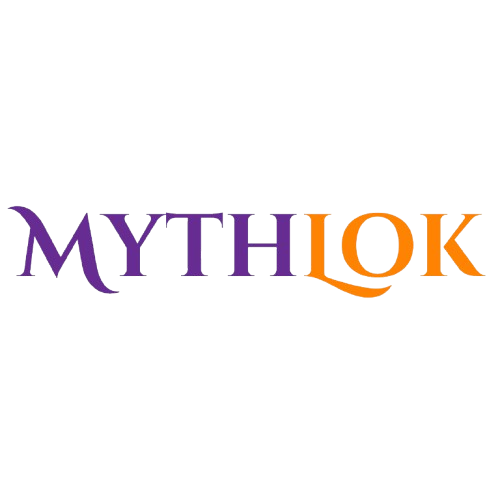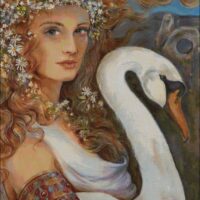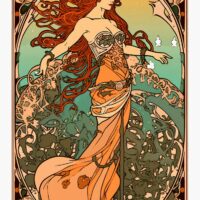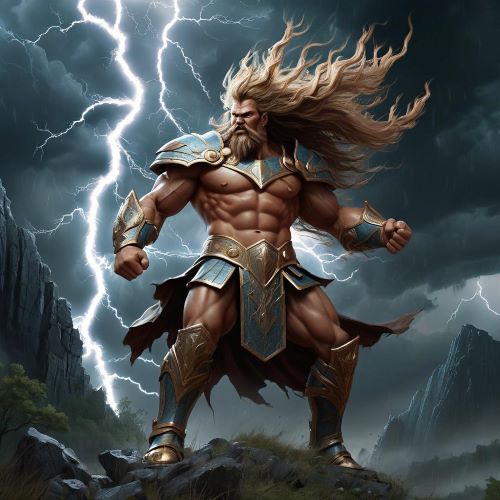Laima : Goddess of Fate
Listen
At a glance
| Description | |
|---|---|
| Origin | Baltic Mythology |
| Classification | Gods |
| Family Members | Kārta and Dēkla (Sisters) |
| Region | Latvia, Lithuania |
| Associated With | Fate, Childbirth |
Laima
Introduction
Laima is a central figure in Baltic mythology, revered as a goddess of fate, luck, and destiny. Predominantly worshipped in Latvia and Lithuania, she plays a crucial role in the life cycle of individuals, from birth to death, marriage, and even the fate of crops and animals. Laima’s influence permeates various aspects of daily life, particularly in matters of fortune, well-being, and success. Her presence underscores the ancient people’s deep respect for the forces that shape human existence and their belief in a divine order governing the world. Known also as Laime or Laimas māte, she embodies the essence of destiny in Baltic mythology. Laima’s role bears similarities to that of the Hindu goddess Lakshmi, who represents prosperity and fortune.
Physical Traits
Laima’s physical appearance is largely unknown, with no detailed descriptions or sculptures found in historical texts. However, some scholars suggest she might be associated with the linden tree, a symbol of fertility and femininity in Baltic cultures. This could imply an image of a woman adorned with linden leaves or residing within a grove of these sacred trees. Laima’s connection to the linden tree emphasizes her nurturing and life-giving aspects.
As the patron of pregnant women, she oversees the delicate balance between life and death, weaving the threads of destiny. In mythological narratives, she is often imagined as a beautiful and graceful woman, embodying elegance and benevolence. Laima is typically portrayed in traditional Baltic attire, highlighting her connection to the land and its people. Sometimes, she is shown holding symbols of fertility and prosperity, such as sheaves of grain or flowers, signifying her role in nurturing life and ensuring abundance. Her serene and composed demeanor reflects her wisdom and the critical nature of her responsibilities as the arbiter of fate.
Family
Laima’s familial ties in Baltic mythology are ambiguous. Some traditions portray her as a solitary figure, the sole architect of human destiny. Others suggest a collaboration with Dievas (or Dievs in Latvian), the sky god, in shaping human lives. There is also a theory that she is part of a triad of goddesses, along with Māra (in Latvian mythology) or Gabija (in Lithuanian mythology), representing different aspects of fate or female power.
In Latvian mythology, Laima is considered one of a trinity of fate deities, akin to the Norse Norns or the Greek Moirai. Her sisters, Kārta and Dēkla, share similar functions: Kārta governs adult lives, Laima influences luck and childbirth, and Dēkla oversees children. Together, they shape the course of human existence.
In some traditions, Laima is viewed as part of this triad that governs destiny, with Dekla associated with the past, Laima with the present, and Karta with the future. This mirrors the Greek Moirai, emphasizing the interconnectedness of time and destiny. In other narratives, Laima stands as an independent deity without direct familial ties. Regardless of her familial status, her role remains pivotal, and she is often approached for guidance and blessings in various life events, from childbirth to marriage.
Other names
Laima, known as Laime in Lithuanian and Laimas māte in Latvian, embodies various aspects across Baltic regions. Whether as the weaver of fate or the bestower of blessings, she represents the intricate interplay between fortune and circumstance. The name Laima derives from the Baltic root “laime,” signifying happiness, luck, and good fortune. This connection underscores her role not only in shaping destinies but also potentially steering them towards favorable outcomes. Interestingly, Laima shares similarities with the Slavic goddess Dola, both associated with fate and destiny.
Across the Baltic region, Laima is recognized by several names, such as Laimė in Lithuanian and Laima in Latvian mythology. Despite these linguistic differences, her attributes and functions remain consistent—guardian of fate, provider of luck, and promoter of prosperity. Variations like Lauma and Laimė reflect regional dialects and local traditions but consistently refer to the same deity. This diversity of names emphasizes her significance and the diverse ways she was venerated across Baltic communities.
Powers and Abilities
Laima, revered across Baltic mythology, wields vast powers that encompass every facet of human life and the natural world. As the goddess of fate, she holds sway over the destinies of individuals, determining their life paths and outcomes with finality. This role reflects a deep-seated belief in a predetermined order, where Laima’s decisions are perceived as unalterable, shaping not only lifespan but also fortune, health, and happiness.
Central to Laima’s divine portfolio is her role in childbirth and infant welfare. Expectant mothers invoke her protection for safe deliveries and the health of newborns. Ritual preparations, such as cleansing the birthing environment, ensure her smooth arrival, while offerings express gratitude for her blessings upon successful births. Laima’s influence extends beyond infancy into marriage and family life, where she fosters prosperity and harmony. Unmarried individuals seek her guidance for favorable unions and enduring relationships, highlighting her role as a patron of domestic well-being.
In addition to her influence on personal destinies, Laima holds dominion over nature and agricultural fertility. Farmers and communities appeal to her for abundant harvests and favorable conditions, believing her blessings can ensure the growth of crops and the fertility of the land. Her care extends to animals, particularly cows and horses, whom she protects and blesses with vitality and reproductive success. Some accounts even attribute to her the ability to regulate natural cycles, such as the length of the day and the lifespan of plants, further emphasizing her role as a steward of the natural world.
Spiritually, Laima serves as a mediator between humanity and the divine realm, offering guidance and foresight in matters of fate and fortune. Her prophetic abilities are revered, as she foretells the destinies of newborns and provides clarity in times of uncertainty. The triad of Laimas sometimes delivers conflicting prophecies, but their final pronouncements are deemed irrevocable, echoing the concept of the Greek Moirai. Laima’s profound influence and multifaceted roles underscore her significance as a compassionate yet formidable deity in Baltic mythology, embodying the intricate interplay between human existence and cosmic order.
Modern Day Influence
Despite the gradual decline of Baltic mythology over time, Laima’s legacy remains deeply entrenched in the cultural fabric of Latvia and Lithuania. Artists, poets, and thinkers continue to draw inspiration from her timeless presence, finding creative expression in various forms of art and literature. Throughout history, rituals dedicated to Laima have served as a testament to her enduring influence, symbolizing a reverence that transcends generations.
In modern Baltic cultures, Laima symbolizes luck and destiny, her name woven into cultural expressions and everyday practices. For example, the Latvian greeting “Laimīgu Jauno Gadu!” (“Happy New Year!”) reflects a collective wish for Laima’s blessings in the coming year, showcasing her ongoing significance in seasonal celebrations. This cultural continuity underscores Laima’s role as a guardian of prosperity and well-being, resonating deeply in the collective consciousness of the Baltic people.
Laima’s influence extends beyond traditional customs into contemporary expressions of identity. Folklore, literature, and the arts continue to celebrate her as the arbiter of fate and the giver of good fortune. Her portrayal in traditional songs, poems, and stories reinforces her mythic stature, ensuring that her role in shaping human destinies remains vividly alive in Baltic narratives.
Moreover, Laima’s name has found resonance in modern commerce and popular culture, exemplified by the presence of the Laima chocolate brand in Latvia. This commercial use not only reflects her association with sweetness and delight but also demonstrates how ancient mythological symbols can adapt and thrive in new contexts, bridging the gap between past beliefs and contemporary lifestyles.
While the flames of traditional Baltic religion may have dimmed over time, Laima’s enduring legacy continues to illuminate the cultural landscape of Lithuania and Latvia. Her presence in folk traditions, artistic expressions, and spiritual revivals underscores her timeless relevance as a symbol of fortune, fertility, and the intricate interplay between human lives and cosmic order.
Related Images
Frequently Asked Questions
What is lorem Ipsum?
I am text block. Click edit button to change this text. Lorem ipsum dolor sit amet, consectetur adipiscing elit. Ut elit tellus, luctus nec ullamcorper mattis, pulvinar dapibus leo.
What is lorem Ipsum?
I am text block. Click edit button to change this text. Lorem ipsum dolor sit amet, consectetur adipiscing elit. Ut elit tellus, luctus nec ullamcorper mattis, pulvinar dapibus leo.
What is lorem Ipsum?
I am text block. Click edit button to change this text. Lorem ipsum dolor sit amet, consectetur adipiscing elit. Ut elit tellus, luctus nec ullamcorper mattis, pulvinar dapibus leo.
What is lorem Ipsum?
I am text block. Click edit button to change this text. Lorem ipsum dolor sit amet, consectetur adipiscing elit. Ut elit tellus, luctus nec ullamcorper mattis, pulvinar dapibus leo.
What is lorem Ipsum?
I am text block. Click edit button to change this text. Lorem ipsum dolor sit amet, consectetur adipiscing elit. Ut elit tellus, luctus nec ullamcorper mattis, pulvinar dapibus leo.













